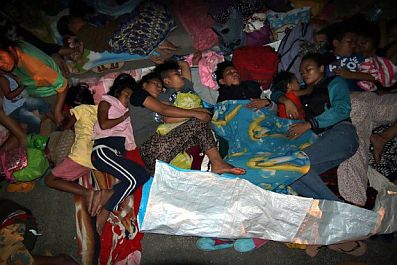
This picture taken on Feb. 11, 2017, shows Surigao City residents sleeping on the pavement on the grounds of the Provincial Capitol where they take shelter from strong aftershocks of the 6.7-magnitude earthquake that hit Friday night, Feb. 10,2017.
Thousands of residents of Surigao City in Mindanao huddled on the streets Sunday, two days after a deadly quake, as aftershocks continued to hit the region.
The 6.7-magnitude quake struck Surigao and nearby areas late Friday, killing six people and injuring more than 200 others, with more than a thousand homes destroyed or damaged, according to officials.
People who fled their damaged homes wrapped themselves in blankets and sacks for a second night as they slept side by side on the pavement on Saturday, an AFP photographer at the scene said.
The state seismology office in Manila said it had recorded 130 weaker quakes in Surigao, a city of 152,000 people, and in the predominantly agricultural region around it since the quake struck.
However, authorities said there were no reports of further casualties or damage.
Early on Sunday, long lines of people carrying pails and jugs queued for water rations supplied by fire trucks after the quake cut off tap water supply.
“We’re still being hit by aftershocks, and as of now we do not have tap water supply. The people are suffering,” provincial information officer Mary Escalante told ABS-CBN television in an interview.
“Buildings that suffered structural damage have been closed,” she said, adding some schools and gyms that were meant to serve as evacuation centres were among those damaged by the quake.
The quake also damaged bridges and roads and knocked out the power supply, though electricity was restored in most of Surigao on Saturday.
President Rodrigo Duterte was scheduled to visit the city on Sunday to inspect the damage and lead the relief effort, officials said.
An average of five earthquakes, most of them undetectable except through instruments, hit daily across the Philippines, which lies on the so-called Ring of Fire, a vast Pacific Ocean region where many earthquakes and volcanic eruptions occur.
The last lethal quake that hit the country measured 7.1-magnitude. It left over 220 people dead and destroyed historic churches when it struck the central islands in October 2013. /INQUIRER.NET